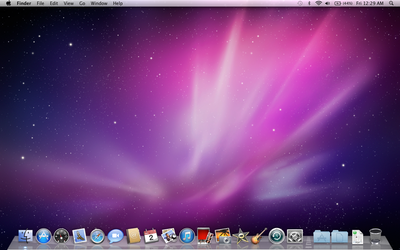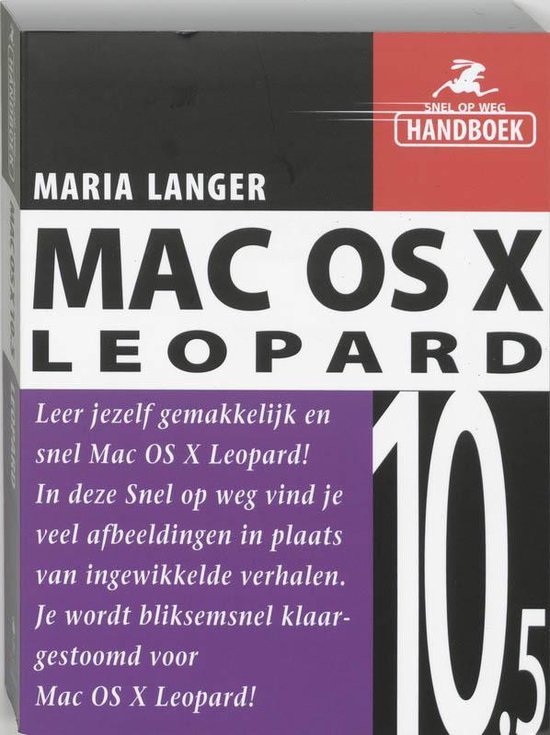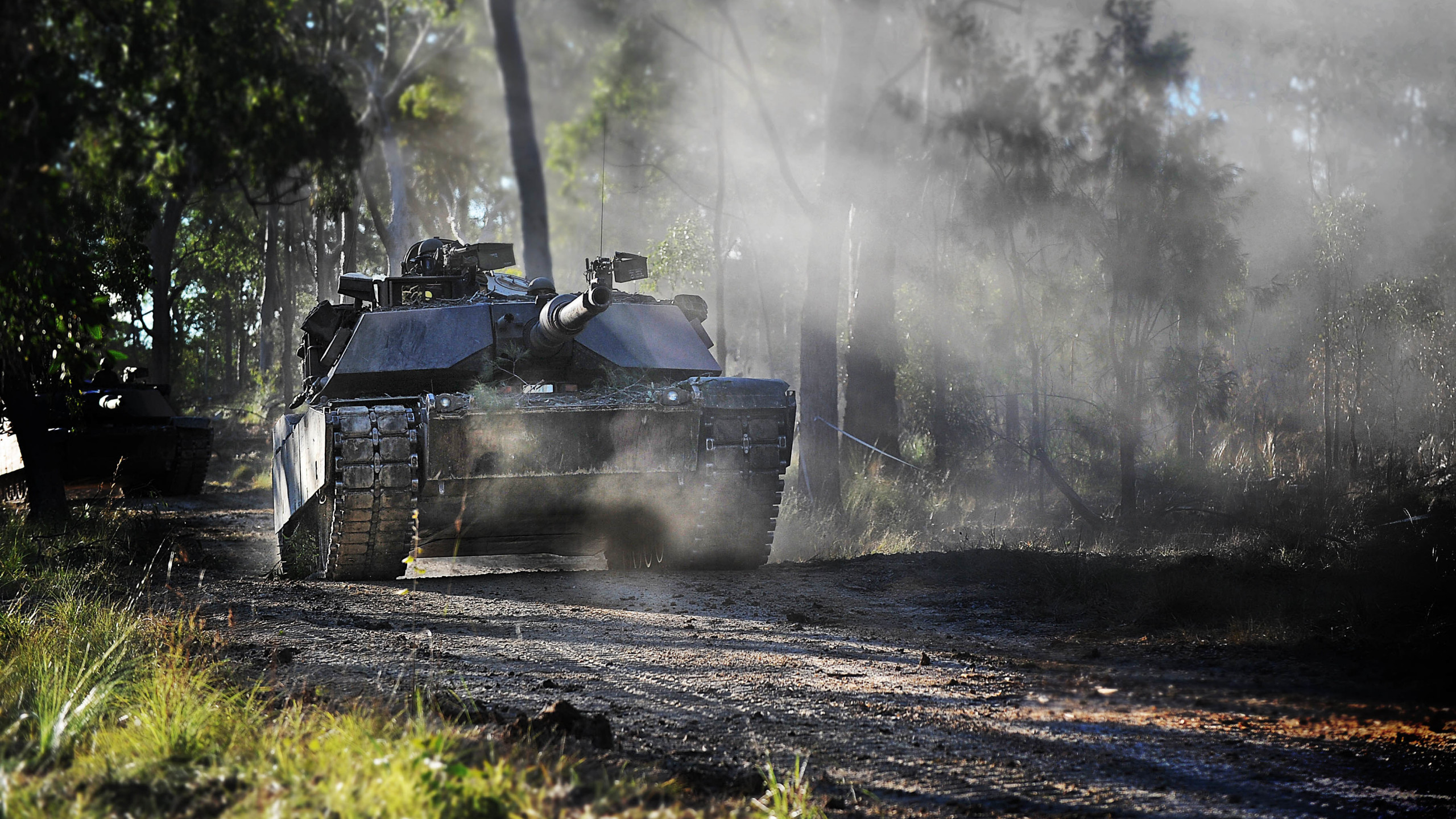The OS X Leopard Guided Tour from www.Apple.com/MacOSX/GuidedTour/.' Grab a front-row seat for a walkthrough of the top attractions in Mac OS X Leopard.
- Leopard is an Open Brand UNIX 03 registered product on the Intel platform. It was also the first BSD-based OS to receive UNIX 03 certification. Leopard dropped support for the Classic Environment and all Classic applications, and was the final version of Mac OS X to support the PowerPC architecture. Version 10.6: 'Snow Leopard'.
- When performing an Archive and Install, use the installation CD for the current version of the operating system that installed on the computer. For example: If your computer came with Mac OS X 10.4 (Tiger) but you upgraded to Mac OS X 10.5 (Leopard), Archive and Install using the Leopard CD's.
- Mac OS X v10.5 Leopard Installation and Setup Guide If you already have Mac OS X v10.3 or later installed on your computer: All you need to do is upgrade to Leopard. See “Upgrading Mac OS X” on page 1. To install a fresh system, erase your hard disk before installing Mac OS X, or install additional software.
We have had time to get used to Mac OS X 10.5 Leopard. How does it compare to the legendary Mac OS X 10.4 Tiger?
Progress
It took a long time for Apple to get OS X right.
Version 10.0 was a stab in the dark, and 10.1 made things a bit better. OS X 10.2 Jaguar was the first proper edition, but it still had a long way to go. Mac OS X 10.3 Panther was not the best edition, but it was definitely better than the previous ones.

When Apple brought out 10.4 Tiger, it was amazing. Tiger became the longest running version of OS X, and I was wondering how Apple was going to top it. Then 10.5 Leopard came out with its fancy new features and power hungry visuals – but under the hood, in an everyday situation, how does it compare?
I have run both Tiger and Leopard. I even ran both on the same machine to give it a fair comparison: an Intel iMac Core Duo 1.83 GHz with 2 GB of RAM.
As you might expect, Tiger (version 10.4.11) flew along. Universal Binary apps screamed along, with the smaller ones opening in one or two bounces of the Dock icon. PowerPC apps took a little longer to open, but we are comparing operating systems here, and not system architecture.
Moving to Leopard
After wearing in the shoes of Tiger for a few months, I wiped the hard drive and did a fresh install of Leopard. Things were not as rosy. The whole machine felt slower – boot time was slower, and loading time was a little slower. My iMac may not be top of the range (getting on three years old), but it is way above the minimum specifications for Leopard (which are an 867 MHz G4 with 512 MB of RAM), so I was a little disappointed.
With any new operating system, you expect some bugs. That’s one reason for system updates. As I write this, we’re already on the fifth major update for Leopard, but at the time I was testing Leopard, Apple had just released 10.5.3. The first few updates made a huge difference to stability, speed, and system performance.
We have to bear in mind that we had a grand total of eleven updates for Tiger, and some these made massive differences, especially the earlier ones.
Comparing the two operating systems at launch, I would have to say that Tiger was more bug-ridden than Leopard and broke more apps than Leopard did. I only had one application, the hard drive cloning tool SuperDuper, that expressly said Not for Leopard. Tiger, on the other hand, broke most of my apps on its launch.
Mac OS X Tiger was released as a PowerPC operating system, and the first Intel version was 10.4.4; Leopard was a Universal Binary from day one, streamlined and getting ready for Apple’s impending decision to leave the PowerPC platform altogether.
Visually, Leopard introduced some new handy features in the Finder. Cover Flow is an obvious hit, as well as Stacks. While using my other machine, which has Tiger on it, I miss these features.
For me, Tiger is still the best. While Leopard has a lot of handy features, if your machine isn’t way above minimum specs, you will notice a drop in performance.
Maybe this will be addressed in future system updates. Performance and speed have already been improved with the first five updates. Tiger still runs very well on an old G3. I am writing this on a Pismo PowerBook G3 (400 MHz G3, 1 GB RAM, 40 GB hard drive) – and it smokes.
If you have the machine to run Leopard well, I would suggest it – after cramming in as much as RAM as possible. However, if you’re running anything lower than a 1 GHz G4, stick with Tiger.
Both operating systems are fabulous. There isn’t much difference for the average user between the two except some fancy effects and a simpler way of connecting to other machines on your network.
I run both and love both of them. Being a lover of older Macs (G3s especially), Leopard is sometimes not an option, so Tiger has a special place in my heart. But for any machine capable of running it well, I’d install Leopard.
Follow Simon Royal on Twitter or send him an Email.
Like what you have read? Send Simon a donation via Tip Jar.
keywords: #tiger #leopard #techspectrum #simonroyal
short link: http://goo.gl/rHf3wh
searchword: tigerorleopardbest
Os X Leopard

Mac OS X 10.5 Leopard, released on October 26, 2007, was the biggest change to Mac OS X since Apple first released OS X 10.0 in March 2001. For the first time, a version of OS X was certified as Unix, and the new unified appearance makes Leopard friendlier and less confusing for users.
Leopard itself was also a unified operating system. Where Mac OS X 10.4 Tiger had come in separate versions for PowerPC and Intel Macs, the Leopard installer could run on both platforms, and the version of Mac OS X installed could boot either type of hardware. New features included Time Machine automated backup, Stacks, and Cover Flow.
But with every big step forward in features and performance, the Mac OS leaves some older Macs behind. The number of Macs that had been supported by Tiger and left behind by Leoaprd was the biggest for any release of OS X to date: No G3 models were supported, and the installer would not run G4 Macs slower than 867 MHz, although a few workarounds were discovered to address that.
Leopard is immune to the “goto fail” bug identified in early 2014.
After 22 months as the current version of OS X (only Tiger lasted longer, at 30 months), Leopard was succeeded by 10.6 Snow Leopard on August 28, 2009, the first version of OS X to leave all PowerPC Macs behind.
- Leopard Forum, our online group for OS X 10.5 users.
- Leopard List, our email group for Mac OS X 10.5 users.
- Unsupported Leopard Installation, 2007.10.31. How to install Mac OS X 10.5 on unsupported hardware – plus field reports.
- Faking Out the Leopard Installer with Open Firmware, Dylan McDermond, 2007.12.06. You don’t have to hack the installer to make the Mac OS X 10.5 installer run on sub-867 MHz G4 Macs by using this simple Open Firmware trick.
Last Compatible Software
These are the last versions of software compatible with OS X 10.5 Leopard.
From Apple
From Other Vendors
- Adobe Flash Player
- PowerPC: 10.1.102.64
- Intel: 10.3.183.1
Leopard Links
- Why Spaces Is My Favorite Leopard (and Snow Leopard) Feature, Charles W Moore, Miscellaneous Ramblings, 2009.11.23. Spaces, a feature introduced with OS X 10.5, is like having several monitors on your Mac without the cost and space of using multiple displays.
- The Leopard Experience at 867 MHz, Simon Royal, Tech Spectrum, 2008.12.02. Mac OS X 10.5 requires an 867 MHz G4 with 512 MB of memory, but is performance really acceptable on a minimum spec system?
- Does Constant Time Machine Activity Compromise Disk Longevity?, Charles W Moore, Miscellaneous Ramblings, 2008.09.15. Time Machine is a marquee feature of Mac OS X 10.5, but isn’t all of that disk activity likely to wear our your drive prematurely?
- SheepShaver Brings Classic Mac OS to Intel Macs and Leopard, Alan Zisman, Mac2Windows, 2008.05.20. Mac OS X 10.5 doesn’t support Classic Mode. Neither does Leopard. But SheepShaver lets you emulate a PowerPC Mac and run the Classic Mac OS.
- Restoring a Crashed Mac with an Install Disc and Time Machine, Alan Zisman, Zis Mac, 2008.02.06. Thanks to Leopard’s Time Machine backup feature, it’s easy to restore your Mac to an earlier setup if you’ve inadvertently deleted essential files.
- Leopard different, a bit buggy, but worth the upgrade, Adam Robert Guha, Apple Archive, 2007.11.02. Leopard on a Power Mac G4 and a MacBook Pro: It runs well on both computers, but each has some odd bugs, and some of the changes are a step backwards.
Downloadable Updates
Standalone Updates let you update to a newer version of Mac OS X from your hard drive instead of using Software Update, which requires an Internet connection. Download the one(s) you need and install them after mounting the disk image and launching the Installer program.
There are two types of Standalone Updates: Individual (or Delta) and Combo.
- Individual Updates update one version of Mac OS X to the next version. For example, the Mac OS X 10.5.4 Update updates Mac OS X 10.5.3 to version 10.5.4. Individual Updates are also known as Delta Updates.
- Combo Updates update the base version of a Mac OS X release to the version specified in the Combo Update, including all intermediate updates. For example, the Mac OS X 10.5.4 Combo Update updates any earlier version of Mac OS X 10.5 to Mac OS X 10.5.4 using a single installer, as opposed to installing the individual Mac OS X 10.5.1, 10.5.2, 10.5.3, and 10.5.4 updates.
Standalone Updates are generally available 24 to 48 hours after the Update is available through Software Update.
Os X Leopard Desktop
If you burn a Standalone Update to CD, its disk image must be copied to your desktop or another location on your Mac OS X startup disk in order to be installed.
Os X Leopard Bootable Usb
This page will be updated as new Standalone Updates become available.
Mac Os 10.5 Leopard Download
Mac OS X 10.5.1
Mac OS X 10.5.2
Mac OS X 10.5.3

Mac OS X 10.5.4
Mac OS X 10.5.5
Mac OS X 10.5.6
Mac OS X 10.5.7
Mac OS X 10.5.8
Keywords: #osxleopard #macosxleopard


Short link: http://goo.gl/mnwm3f
searchword: osxleopard
